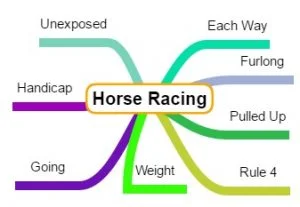
Fact To File’s Ryanair Chase Prediction: Overrated or Underdog at Cheltenham 2025?
The 2025 Cheltenham Festival, occurring March 11-14 across 28 events, becomes the battlefield in the Ryanair Chase on March 13th—can Fact...
 It’s the oldest sport in terms of betting, and still one of the most popular. But there’s no doubt that horse racing has a language all of its own.
It’s the oldest sport in terms of betting, and still one of the most popular. But there’s no doubt that horse racing has a language all of its own.
For those steeped in horse racing, the jargon is second nature. However, to newcomers, the specialized language might seem like an enigma. Whether you’ve perused a racing publication, or tuned in to a live race broadcast, it can be baffling. stream horse racing online , you’ll know exactly what we mean.
We get it. Before placing your first betting wager, you aim to decipher the specialized vocabulary associated with the sport. Hence, we crafted this comprehensive guide to demystify the essentials you should grasp about horse racing terminology. recommended horse racing bookies Now, let's delve into the horse racing jargon frequently encountered and provide clarity on what each term signifies.
The term 'going' refers to the surface condition of the race track. In turf racing, it varies from heavy—signifying wet conditions likely to decelerate the horses—to firm, indicating a hard and unyielding surface. Race officials report the going at daybreak, but it is subject to change, particularly in inclement weather.
Most reputable online racing bookmakers prominently display the going on their betting slips.

By examining a horse's previous performance records, you can gauge its past races on varying surfaces. This insight aids in predicting its potential performance in upcoming races.
Essentially, firm going implies quick ground, contrasting with softer surfaces, which tend to slow down both horses and runners. Visualize running on dry, firm turf versus muddier, moist terrain—you’d expect a speedier pace on the former, just like the horses.
A furlong measures out to about 1/8 of a mile, equivalent to 200 meters. In UK and Irish racing, distances are delineated in miles and furlongs, with the shortest sprints being approximately 1 kilometer.
WD stands for Withdrawn, indicating a horse was taken out of the line-up before the start, often a trainer’s decision.
UR represents Unseated Rider, logged in race results or past performance sheets, indicating a rider fell off during the event, which can be due to either judgement calls or unforeseen circumstances.
In racing parlance, 'pulled up' denotes a horse ceased taking part mid-race, usually upon the jockey's discretion, perhaps owing to a perceived lack of winning chances or emerging injuries.
What signifies being 'Unexposed' in horse racing?
A horse's initial seasonal appearance or its comeback following substantial rest.
When a racehorse is 'up in trip,' it denotes a participation in a longer-than-usual event. One must consider if the horse can manage the longer stretch. However, the trainer might believe the horse thrives over extended distances.
In UK racing, classifications distinguish events by the caliber of horses contesting and the prize allocations, with 'Under Rules' implying all professional races within governing regulations, excluding amateur point competitions.
A phrase primarily heard stateside: When wagering on a placement, one bets on a horse to finish in the top two; for a Show, the horse can culminate in the top three.
Place wagering varies in the UK, as payouts depend on the number of contenders. Some bookmakers offer extra payout positions for select events, steering away from the American 'Show' bet format in UK contexts.
A term coined by racing tipsters, although applicable to other sports domains, designating a day’s prime bet.
Found in racing tip listings, NB represents Next Best, ranking just below the 'nap' in recommendation.
Slang amongst the betting sphere: A 'jolly' is a favored contestant supported by gamblers, while a 'rag' is an unfavored entrant.
This principle concerns adjustments to your bet’s odds following a horse's withdrawal post-stake.
Day 4 Tips The removal translates to a higher winning probability for the remaining selections, thus the bookmaker automatically reduces odds, thereby aligning your expected payouts.
Referred to at times as the Reduction Factor, determined via the withdrawn horse’s odds, automatically managed by bookmakers for your convenience.
For intricate Rule 4 details, peruse Tattersall’s Racing Guideline PDF.
In UK horse racing, divisions into varying tiers reflect the level of competing horses and the stakes involved. The Group classification, split into groups 1 through 3, signifies pinnacle races.
Listed races, a step down from Group status, still remain prestigious and attract high-caliber competition and rewarding prizes, stirring more betting interest than lower-ranked races.
The Triple Crown in UK horse racing entails an epic triumph in the year's trio of premier events—the 2000 Guineas, Epsom Derby, and St Leger—all within a single season.
Such a feat is monumental, achieved only 15 times historically, last by Nijinsky in 1970.
Comprehensive roster of UK Triple Crown Champions available.
In UK & Irish racing, two distinct seasons emerge. The winter heralds National Hunt, characterized by jumping challenges, while summer suits Flat racing—firmer ground is less conducive to jumps, making mid-year perfect for flat tracks.
Ultima Handicap Chase Tips Bumper races meld these formats, offering flat hunting experiences to acclimate equines to local courses sans barriers, honing their skills for future jump campaigns. .
We’re hopeful this guide provided clarity and addressed your curiosities. If so, perhaps you're prepped for your inaugural wager, so examine our
directory of top-tier online bookmakers
. If this guide fell short, your insights can shape our page .
Have we overlooked any horse racing terms you’re curious about? Please Turners Novices’ Hurdle Tips inform us. Our glossary evolves with your input, and we’re keen to include your inquiries.
If this guide proved beneficial, consider backlinking to us, or sharing with others.
